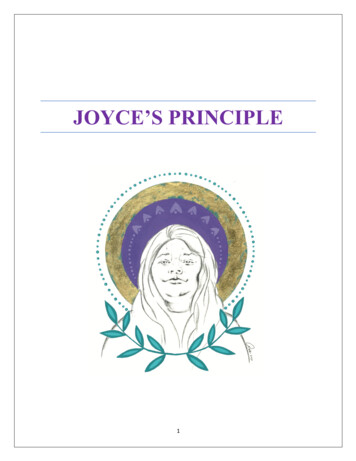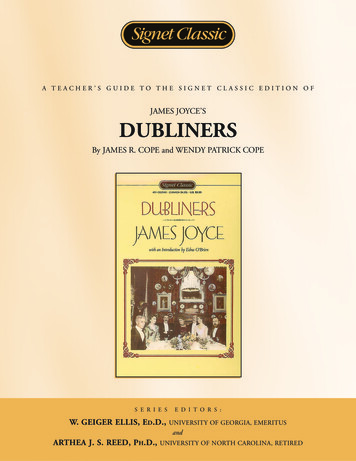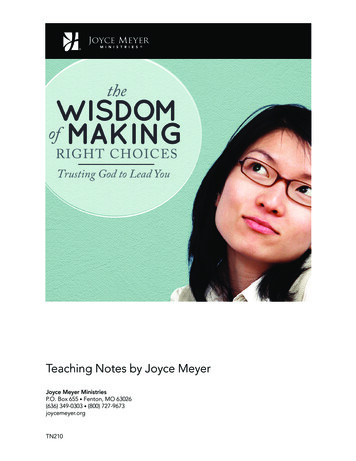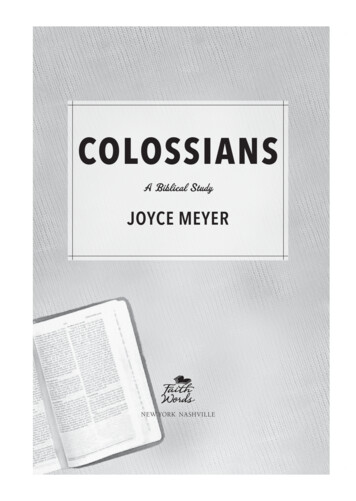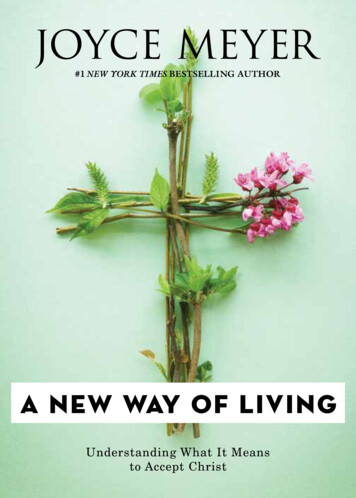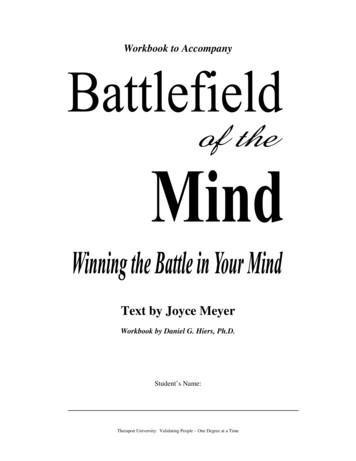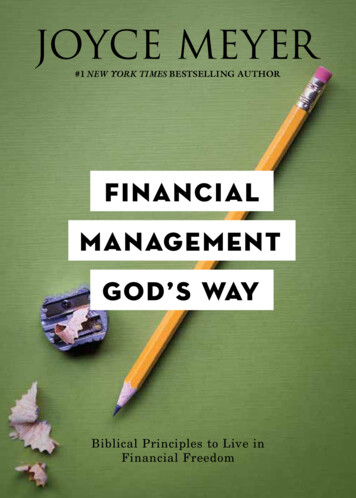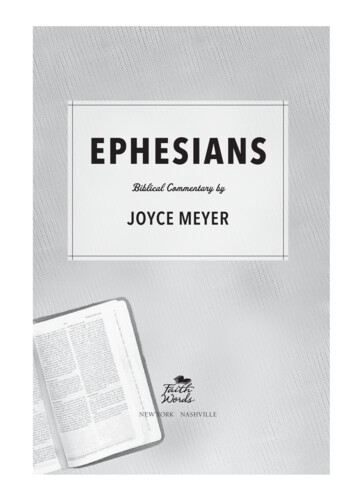
Transcription
JmJoyceEdited by Burc;in ErolDepartment of English Languageand LiteratureHacettepe UniversityandThe Embassy of Ireland
Hacettepe University, Department of English Languageand Literature, 2012Ankara, TurkeyPrinted by Bizim BfuoCover illustration: Portrait of James Joyce by BarrieMaguire with the courtesy of the painter.Cover design by Sinan Aktlh
Table of ContentsForeword1. From the National to the Transnational: Joyce'sEver-expanding Fictions . . . . . . . . . . . . . . . . . . . . . . . . . . . . . . . . . . . . . . . . 1John Mccourt2. James Joyce's Ulysses: A Homeric ParodyRevisited. 20Himmet Umunv3. Translating James Joyce into Turkish.N. Berrin Aksoy354. The Irish Pub: A Restorative Milieu for Farrington inJames Joyce's "Counterparts" . 49A. Deniz Bazer5. "Performative Acts" in "The Dead" . . . . . . . . . . . . . . . . . . . . .Aytiil Orum686. James Joyce: The Man in His Letters.Alev Karaduman837. From Stephen Hero to A Portrait A Debate onAesthetics. 97Zeynep Z. AtayurtNote on Contributors .113
ForewordThis volume is comprised of the articles focusing ondifferent aspects of the works ofJames Joyce.Originally the shorter versions of the articles werepresented at the "One Day, James Joyce Conference"held by the Department of English Language andLiterature of Hacettepe University in collaborationwith the Embassy of Ireland in Ankara, December5,2011. Among the articles which present in depthstudy of some of Joyce's works is also one that isspecific to studies related to the Turkish translations.The other point that makes the Conference andthe collection of articles special is the support of theEmbassy of Ireland. Ireland has been the country ofnumerous writers who have significant place inEuropean and world literature. The choice of JamesJoyce as the first of the Irish Writers Conference serieswas a conscious one as Joyce is among the three mostread of the artists who write in English, the other twobeing Shakespeare and Dickens. It is worthmentioning once again the importance of the officalsupport of the Irish goverment in sharing this literaryand cultural richness with the world.I would like to once again express my thanks tothe former Ambassador of Ireland His ExcellencyThomas Russel and His Excellency Kenneth Thomsonthe Ambassador of Ireland to Turkey. Thanks are alsodue to Prof. Dr. Ugur Erdener, the former Rector ofHacettepe University and Prof. Dr. Musa Ya§arSaglam, the former Dean of the Faculty of Letters.Bur inErol
1From the National to the Transnational: Joyce'sEver-expanding FictionsJohn Mccourt'I might easily have written thisstory in the traditional manner. [. ]Every novelist knows the recipe. [. ]It is not very difficult to follow asimple, chronological scheme whichthe critics understand.' (Joyce qtd.in Jolas 11-12)Joyce wanted to be simultaneously a writer whowas both Irish and European. Thus he became acentral figure of the international modernist movementbut did so while remaining peculiarly 'national' in hisinterests, setting all of his works in his native city,with the exception of the brief but evocative Triestinepoem-in-prose, Giacomo Joyce. Joyce believed that hiswriting took on an international dimension preciselybecause of its rootedness in Ireland. As he told ArthurPower, the world's great writersI
From the National to the Transnationalwere national first [. ] and it wastheintensityoftheirownnationalism which made theminternational in the end [. ]. Formyself, I always write about Dublin,because if I can get to the heart ofDublin I can get to the heart of allthe cities in the world. In theparticulariscontainedtheuniversal.' (qtd. in Ellmann 505)Part of Joyce's originality lay in his ability tocombine a fidelity to his local Irish world with anexpansive sense of the global, to engage in a constantact of cultural translation, to distil into his fictionelements from both his abandoned but ever-presentIreland and from his chosen exile in various Europeancities.We need look no further than the Blooms forevidence of this: Leopold, the most unlikely of 'hero' foran Irish national epic, is at once Irish and RomanCatholic as well as being the son of a HungarianJewish emigrant; while Molly, born in 1870 inGibraltar, a 'Spanish type' who becomes 'Mrs Bloommy wife the prima donna, Madam Marion Tweedy' (u'652.37) and is 'the accomplished daughter of MajorBrian Tweedy' (U 652.41). Her father served with theRoyal Dublin Fusiliers and fought at Rorke's Drift andPlevna and is representative of the British Empirewhile at the same time resembling 'moustached .Turko the Terrible'. He mother was a Spanish Jewishcalled Lunita Laredo. Like Bloom, in a sense she is2
John Mccourtboth Jewish and Catholic. The mixture of identitiesembodied in the Blooms are constitutive of Joyce'ssense of transnational realities, of his belief that racialpurity can never be anything other than a fiction, ofhis desire to write an Irish novel that is also, infundamental ways, European. Although both Leopoldand Molly Bloom are clearly connoted as Dubliners, itis their 'foreign' qualities that spark their initialmutual attraction. Bloom appreciates Molly's being'Spanish, half that is' (U 16. 876), her having the'passionate abandon of the south' (U 16.1409) whileMolly has told him that she chose him 'Because youwere so foreign from the others' (U 13.1209-10). In'Nausicaa' Gerty MacDowell similarly notices him as'that foreign gentleman' (U 13. 1302). Strictly speaking,of course Bloom is not a foreigner, having been born inDublin, just as he is not really or halachically a Jewsince his mother was not Jewish and he was nevercircumcised.Hybrid, mixed-middling Bloom is a Dubliner witha most unusual Mitteleuropean family background inSzombathely in Hungary. As Connac O'Grada hasshown in his history of the Jewish community inIreland, Joyce would have found no prototype for thisfigure in Dublin. 1 The Dublin Jewish community wassmall and mostly came from further east thanHungary. Bloom, 'a citizen of the British Empire' and'an Irishman', is marked out by his being so mixed, sodifferent, half belonging to a variety of worlds. He is 'aJew, a European but an Oriental both because he is a1Cormac O'Grada, Jewish Ireland in the Age of Joyce. A Socioeconomic History(Princeton: Princeton University Press, 2006).3
From the National to the TransnationalJew and because he is Irish' (Kershner 291). He is alsoa Mediterranean man, who appreciates beauty andlikes looking at women. His breakfast of inner organswas more a speciality of Trieste than it was of Dublin,while his chosen repast of 'a few olives too if they hadthem. Italian I prefer. Good glass of burgundy takeaway that. Lubricate. A nice salad, cool as a cucumber'(U 8. 758-762) and his actual snack of burgundy,olives and Gorgonzola cheese certainly owes more tothe Triestine than to the Dublin diet. These 'foreign'features owe much to Trieste and to Joyce's friendthere, Ettore Schmitz (better known under hispseudonym, Italo Svevo). Bloom is also connoted as anOriental, 'at his best an exotic tree which, when rootedin its native orient, throve and flourished and wasabundant in balm, but, transplanted to a clime moretemperate, its roots have lost their quondam vigour' (U14.937-40), one who 'hitches his belt sailor-fashionand with a shrug of oriental obeisance salutes thecourt, pointing one thumb heavenward' (U 15. 959961). His Jewishness derives from his being ofHungarian-Jewish extraction, and is signaled by theclassical (Rabbinical) oriental looks attributed to himby Joyce: 'height 5 ft 91/2 inches, full build, olivecomplexion, may have since grown a beard, when lastseen was wearing a black suit' (U 17. 2002-2004).Furthermore, 'Bloom's 'relish for the inner organs ofbeasts' is a cultural marker of Jewish identity - onewhich becomes completely secularised with the porkkidney' (Davison 201). He is a child of Israel wanderingin the wilderness, longing for the sustenance of fruit,thinking of his family roots in the East, in Palestine,and of the passage from there to the Mediterranean, apassage which mirrors that of Molly through Spain,4
John McCourtGibraltar, the Mediterranean- across Europe toDublin. Bloom also thinks Molly's bed made a similartrip 'from Gibraltar by long sea long ago' (U 15. 3289).It is useful to bear in mind two contemporarysource spaces feeding not only into the makeup ofBloom's character but into the entire rich tapestry thatis the Ulysses text. The combination of both a Dublinand a foreign lens opens up Joyce's text and revealsjust how much the writer imported from abroad. Thusthe experience of reading Joyce cannot but beenhanced ifwe use what Joyce calls 'doublingbicirculars' (FW 295.31) and attempt to see Joyce's'double densed' work (FW 365.18) 'from a double focus'(FW 349.13). This is not to call for a return to seeingJoyce as a rootless international modernist cut offfrom his Irish world, but rather to point to therootedness of his works in his various Europeanhomes and most particularly in Trieste, the principalsource of the non-Irish materials in Ulysses. WhatStephen Dedalus calls 'so familiar and so foreign'referring to the Dean of Studies' English has farbroader ramifications than simply Ireland's semicolonial relationship with its bigger island neighbour.Feelings of familiarity and foreignness accompaniedJoyce throughout his life: in Trieste, for instance hewould have listened to the Austrians and Slavs tryingto speak the native Italian language, or better thedialect of Triestino, which was both a familiar languageand officially a foreign tongue; in Zurich he would haveheard familiar Austrian German turned foreign in theSwiss-German version that was used there. Processesof familiarisation and foreignization are in constant5
From the National to the Transnationalplay and provide his particular literary language withmuch of its energy.Joyce used his forty-year continental exil to findhis way to come to terms with his home and with whatoppressed it. For him, the act of leaving permitted theact of imaginative recreation of what has been leftbehind. On being asked by Mrs Sheehy Skeffinton whyhe did not return to Ireland, Joyce replied: 'Have I everleft it?' (Ellmann 704). This position would become aparadigmatic one for many post-colonial writers andintellectuals writing in Joyce's wake, and often living inan exile that was compulsory rather than chosen.The foreign elements in Joyce's work challengethe native ones and vice-versa. Joyce effectively seemsto pre-empt Edward Said's idea of 'contrapuntalreading' which he introduced in his Culture andImperialism whichstressed theneedfora'simultaneous awareness' both of 'metropolitan history'and 'other histories' (Said 51). Said had in mindEuropean and non-European worlds, Joyce, on theother hand, is thinking of European culture and Irishculture, with Ireland being representative of 'other',this point being made even more pointedly in thecareful juxtaposition of the 'outsider' Irish and Jewishcultures in Ulysses which Joyce referred to as his 'epicof two races (Israel and Ireland)' (SL 70). If doublenessis evidentt e characters and political reach of manyof the top1cal 1ssues in Ulysses, in Finnegans Wake itassumes a textual dimension in the individual wordswher there is a constant double (and sometimesr:iulti?l ) play: Hibemo or Irish-English and foreignlinguistic elements are intricately juxtaposed and!n6
John Mccourtcompete with each other even within individual words,each of which offers allusional evidence to beinterpreted one way or another or better one way andanother. Meaning, never definitive, exists as s and the reader has to constantly wonderexactly what language is being spoken: 'Are wespeachin d'anglas landadge or are you sprakin seaDjoytsch?'(FW 485.12-13).Joyce's Irishness is what roots his works but healso wanted to show that Irishness was, like everyother identity, a mere construction and one which hewould relentlessly interrogate in his fiction. He knewhe would not be thanked at home for doing so. InStephen Hero, Stephen Daedalus is taken to task bythe Gaelic Revivalist Hughes who tells him:'They wanted no foreign filth. [. ]the Irish people had their ownglorious literature where they couldalways find fresh ideals to spurthemontonewpatrioticendeavours. Mr Daedalus washimself a renegade from theNationalist ranks; he professedcosmopolitanism. But a man thatwas of all countries was of nocountry - you must first have anation before you can have art.' (SH95)Part of the originality of Joyce's writing is toconstantly juxtapose an art which is undeniably7
From the National to the Transnationalnational (although never nationalist), undeniably Irish(although never provincial) with one that is equally 'ofall countries'. Writing at a time in which variousEuropean nationalisms were increasingly openlydisparaging 'foreign filth' in favour of ideas of purity ofrace, language, origin, Joyce constructs a vision of thenation in his fiction before the nation is formallyestablished - and de facto contradicts Hughes - whileat the same time deconstructing the very premises onwhich the Irish nation would actually be founded. Formany decades, the essential Irishness of Joyce's worksremained obscured by the Irish who rejected hisattacks on the twin Irish building blocks ofCatholicism and nationalism and by internationalscholars who preferred to see him as an apoliticalEuropean, an internationalist, a high-modernist,cosmopolitan, canonical figure. Joyce himself waspartially responsible for his being cast within thislatter frame. After all, he instructed his biographer,Herbert Gorman, to proclaim that he 'did not meddlein politics in any way. . . his entire devotion andtravail were concentrated on the development andperfection of his art' (Gorman 257).Subsequent readings of Joyce in this key, that isof a Joyce above and beyond politics (meaningnationalist -mostly Irish - politics) were entirely inkeeping with their post-war times. Various of Joyce'sfriends argued in favour of seeing the writer in thiscosmopolitan light and of reading his texts in anahistorical, anti-nationalist manner: among them, EzraPound disputed the need for local knowledge of Dublinin order to read Ulysses and hailed Joyce 'as aEuropean, not as a provincial' (Read 32-33). The need8
John McCourtto see Joyce in this light intensified, especially forcreative writers both during and in the aftermath ofthe Second World War. The Italian novelist, AlbertoMoravia was representative of many when he wrote ofJoyce as 'the incarnation of Europe', of 'a free Europe,where art and literature travelled far and wide likegentle breezes announcing the arrival of spring. AEurope with neither borders nor divisions, where itwas legitimate to change places according to thewhims of literary inspiration' (Moravia 12).What these readings made increasingly clear wasthat in order to become the defining figure within theIrish narrative tradition and to help dislodge 'Christand Caesar', the Roman Catholic and British Empiresthat had colonised the Irish mind, Joyce had felt itutterly necessary to connect his writings andsubsequently reconnect his unsure country withEuropean modernity. Light had to be brought in frombeyond the island. Joyce's inspiration came from manysources that included his fellow exile Dante: 'I loveDante almost as much as the Bible. He is my spiritualfood, the rest is ballast' (Ellmann 218) and Flaubert,whom he admired for his precision, detachment, andminute attention to detail. Joyce also looked to Ibsenwhom he believed had been the most formativeinfluence on his generation and whom he praised forhis 'inward heroism' and his 'absolute indifference topublic canons of art, friends and shibboleths' (SL 7).And all these before we even mention Homer or Vico,presiding spirits haunting Ulysses and FinnegansWake respectively. In Dubliners, Joyce drew onGabriele D'Annunzio's conception of the epiphany asfound in his L'Epifania del Fuoco (The Epiphany of9
From the National to the TransnationalFire) which ,, as the first part of his fl Fuoco (The Fire),a "ork held in the highest possible esteem by theyoung Jo ce. He found in it a way of avoiding theprogressi e chronological direction of so much of thefiction he was reading. Although he never definedexactly what he meant by epiphany, we have aworkable definition from Stephen Daedalus in StephenHero. He says that epiphanies are a sudden andmomentary showing forth or disclosure of one'sauthentic inner self. This disclosure might manifestitself in vulgarities of speech, or gestures, ormemorable phases of the mind. So there is a renewedunderstanding of the self from a seemingly smallactual event. More often than not, the epiphanyhappens for the reader more than it does for Joyce'sprotagonist. In any case, Joyce conceived his collectionof short stories as a sequence of fifteen epiphanieswhich were written to let Irish people take 'one goodlook at themselves in his nicely polished looking-glass'(SL 90). The crucial relationship in Joyce's shortstories is no longer between an omniscient narratorwho, from the first page of a narrative, possesses asense of an ending but between an unsure protagonistwith whom an uncertain reader entersinto ommunio as part of his attempt at personalmterpretation. Expectation of the epiphany is moreoften than not raised only to be frustrated in therea?er ho reads in vain for signs of change orsatisfaction. oyce's forces .his readers - and he was writinprunarily for an Insh audience - to dwell on th absence of hope that permeates his D blintk1·uworld ando see exp anations for it. The frustrating fictions of10
John McCourtDubliners reveal Joyce's early modernist moves: theelimination of the all-knowing narrator, the insistenceon an epiphanic structure exposing otherwise ordinarymoments in ordinary lives, a brooding darkness or anodour of corruption that hangs over the city of Dublinwhich begins to function as an emblematic urbancentre of alienation. Joyce's experimentation in thecircular stories of Dubliners is deepened and developedin A Portrait of the Artist as a Young Man, his radicalrewriting of the abandoned Stephen Hero. The novelcloses with the words 'Dublin 1904 Trieste 1914' asthough to underline the alchemical mixing of nativeand European elements in this, his first publishednovel. Both novels trade in the style of theKunstlerroman but if Stephen Hero belatedly bearsmany of the hallmarks of the nineteenth century novel,A Portrait substantially complicates and sometimesabandons realism as it embraces new modernistgestures. Much of the factual and autobiographicalmaterial of Joyce's own growing up present in StephenHero is erased into the phantasmagorical backgroundin A Portrait. In A Portrait the supporting cast isreduced to a very secondary role so that the focus canbe placed even more firmly on Stephen as an isolatedhero. Stephen's mother becomes a minor voice whileMaurice (a version of the much-put-upon Stanislaus)is refined out of existence (he is remembered just oncein A Portrait and that only so that we can note that hehas been forgotten: '- 0, Holy Paul, I forgot aboutMaurice, said Mr Dedalus' (P 75). Much of the overtpolitics of the earlier work is also erased. Clearly Joycehas bigger fish to fry in addition to his fictionalizationof his own process of maturing in Dublin: he wishes toquestion the very bases upon which a work of art will11
From the National to the Transnationalbe constructed. Joyce's Portrait immediately drawsattention to its own artistry and, with its Latinepigraph from Ovid's Metamorphoses, declares itsintention to transform through layers of myth, symboland artifice. If much of modernist literature is theliterature of retelling, Joyce's Portrait sets out its storein crucially evoking different layers of meaning and inquestioning the traditional role of narrative and ofcreating the illusion of truth (one of the commonestposes assumed in the realistic novel involved the textpresenting itself as a transcription of a real document,an authentic account). Although drawing liberally onautobiographical elements from his own life, Joycenever lets his reader forget that he is reading aconstructed narrative which announces its fictivenature in its 'once upon a time' incipit, the most widelyaccepted convention for opening an oral narrative inthe English language: 'Once upon a time and a verygood time it was there was a moocow coming downalong the road and this moocow that was coming downalong the road met a nicens little boy named babytuckoo . ' (P 3). Soon we are told that it was Stephen'sfather who told him that story. This signals not onlythe centrality of the father figure in the novel but italso underlines the inherited and unoriginal nature ofall stories. Joyce's aim therefore was to tell old tales ina new way; to question the way in which novels arewritten, to place his focus on language and its power.Thus, a formulaic opening, which recalls oral culture,is revitalised into 'and a very good time it was' by aJoyce already on the path to exploding the formulas offiction, making the old new. Young Stephencontributes to the retelling process and places himselfwithin it, drawing our attention immediately to the12
John Mccourtdifficult boundaries between art and reality, to his owngrasp on and ability to transmit reality .Gradually in the novel Stephen's own sense oflanguage develops as it must do because this is theportrait of a future literary artist. Soon Stephen has totry to grasp what exactly being a 'gentleman' meanswhen questioned about his own father and then hefinds himself contemplating the meaning of 'suck . aqueer word' (P 11). The reader can sense him tryingout and enjoying words: 'And the air in the corridorchilled him too. It was queer and wettish' (P 11) and isinvited to participate as Stephen tries to understandhis own place in the world. Later in the novel, by thetime he gets to University, Stephen's broodings onlanguage have matured as the focus narrows untoindividual words, which are no longer dead vehiclesemployed simply for describing other objects, butlively, changing objects of interest in themselves.He found himself glancing from onecasual word to another on his rightor left in stolid wonder that theyhad been so silently emptied ofinstantaneous sense until everymean shop legend bound his mindlike the words of a spell and hissoul shrivelled up sighing with ageas he walked on in a lane amongheaps of dead language. His ownconsciousness of language wasebbing from his brain and tricklinginto the very words themselves13
From the National to the Transnationalwhich set to band and disbandthemselves in wayward rhythms.(P 193)This echoes with a corresponding early paragraph inStephen Hero which opens to the core of Joyce'sfascination with language and shows that Stephen likehis creator, is horrified with people who are 'strangelyignorant of the value of the words they used so glibly'(SH 29).It was not only in Skeat that hefound words for his treasure-house,he found them also a haphazard inthe shoops, on the advertisments,in the mouths of the ploddingpublic. He kept repeating them tohimselftilltheylostallinstantaneous meaning and becamewonderful vocables. (SH 33)This is an anticipation of Joyce's future relationship tolanguage right up to Finnegans Wake. Words, thewords literally picked up in the street, we are told, inorder to be rescued from the hell of hells, which is thehell of the Obvious, must lose 'all instantaneousmeaning', and then they become 'wonderful vocables'.This can be linked to Joyce's use of the epiphany,indeed the language of the Wake as 'a constantepiphanisation of current, familiar, obvious everydaylanguage, by a process of translation that intensifies tothe utmost its semantic values, so that the banal14
John McCourtbecomes memorable, the common word becomes awonderful vocable (Melchiori, 1995: 101). But alreadythis process is in train as words and languages jostlefor prominence in A Portrait 'The word now shone inhis brain, clearer and brighter than any ivory sawnfrom the mottled tusks of elephants. IVORY, NOIRE,AVORIO, EBUR' (P 193).By now words seem to Stephen to exist almost inisolation and are studied as physical formationsemptied of 'instantaneous sense', of their everydaymeanings and thus reborn. In this process Joyce theIrish author is thus interrogating the standard formsof English, is claiming personal control over thelanguage which he has inherited by imposition. Iflanguage begins to be an issue in A Portrait whichalternates between the first and third person, thisdialogic quality mushrooms out into a multitude ofcompeting voices in Ulysses, a novel which placeslanguage use centre stage. Each of the eighteenepisodes is cast in a startlingly unique style and thereader is challenged to make significant adjustmentsso as to cope with a sense of disorientation. Very oftenit seems that the dominant building blocks of thetraditional novel - fixed character and straightforwardplot - or, as Joyce called them in a 1926 letter toHarriet Shaw Weaver, 'wideawake language, cutanddrygrammar and goahead plot', have become optional andthat the dominant presence to emerge from the novelis the city of Dublin itself which is not only brought tolife visually in a way that, among other things, owes adebt to early cinema, but is also made to 'speak' in amultitude of voices. Bloom's observation that'Everything speaks in its own way' (U 7 .1 77) reflects a15
From the National to the Transnationalsignificant part of Joyce's symphonic method ofemploying language in the novel. A few examples give asense of the novel's achievement in conveying everydaynoise in a manner somewhat analogous with that ofthe Italian futurists (whom Joyce came to know inTrieste): The printing press says 'Silt' (U 7.177) while agong sounds as 'Bang Bang Bia Bak Blud Bugg Bloo'heard passing(U 15.189) and a train is'frseeeeeeeefronnnng' (U 18.596). Even Bloom'sbursting trouser button snaps 'Bip!' (U 15. 3441) ashis trousers fall as the Ulyssean cacophony of soundslays the way for the diversified babble of 'the chaosmosof Aile anyway connected' (FW 118.23) which is comingin Finnegans Wake. While here sound is emphasized,what is again relentlessly to the fore is language itselfwhich becomes the unrivalled protagonist of Joyce'slast work.The individual word in the Wake, with itssimultaneous qualities of appearing to be both foreignand familiar to the reader, takes on a life of its own,resists classification and incarnates the idea ofhybridisation, contamination, migration, stratification,assimilation. We should never forget that Joyce waswriting between two world wars, under the threat ofexasperated nationalisms, and the rampant fascismand nazism that were about to tear Europe apart. Bynow one of Joyce's aims was to explode the notion thatEnglish or any other language for that matter could beused as means to classify a race. Joyce came to refusethe very word race, the idea of purity interrogated inthe blend of Irish-German nationalism in the play onthe Irish word for Ireland, Eire, in Finnegans Wake asthe 'eirest race, the ourest nation, the airest place that16
John Mccourterestationed' (FW 514.36-515.1) and instead gave voiceto the 'confusioning of human races' (FW 35.5). Indoing so he gave voice to a union of languages and tothe Europe he had seen from afar, had longed for inDublin and had discovered at first hand in Trieste,Zurich, and Paris. This effect of 'confusioning' is tounite all Joyce readers as foreigners before theprovisionally English text of Finnegans Wake and alsoto empower each and everyone to bring his ownfamiliar language to bear on the limitless linguisticunion that is his last book. And in this lies much ofthe pleasure of the text, the pleasure of depaysement,unfamiliarity. The Russian critic Viktor Shklovskyclaimed that this effect is one of the goals of art andused the term ostranenie, usually translated as'defamiliarization,' to describe it:The technique of art is to makeobjects 'unfamiliar,' to make formsdifficult, to increase the difficultyand length of perception becausethe process of perception is anaesthetic end in itself and must beprolonged. Art is a way ofexperiencing the artfulness of anobject; the object is not important.(Shklovsky 12)J? ce'sexperiences living in unfamiliar Europeancities played a r le in his development of what mightbe called a technique of defamiliarization in his fictionthe technique which allowed him to use the cracked17
From the Na I to the Transnationallooking-glass of his fiction as the place to make hisnative place and native people new and unfamiliarboth to themselves and to others, to allow the Irish to'See ourselves as others see us', to quote LeopoldBloom (U8.661-2).WORKS CITEDJames Joyce, Ulysses, and theConstruction of Jewish Identity: Culture,Biography, and 'the Jew' in Modernist Europe.Cambridge: Cambridge UP, 1998.Ellmann, Richard. James Joyce. Oxford: Oxford UP,Davison,Neil.1982.Gorman, Herbert. James Joyce: A Definitive Biography.London: The Bodley Head, 1941.Jolas, Eugene. "My Friend James Joyce" in JamesJoyce: Two Decades qf Criticism. Ed. SeanGivens. New York: Vanguard Press, 1948.Joyce, James. Stephen Hero. London: Triad Grafton1989 fl944l. A Portrait of the Artist as a Young Man. London:Penguin, 2000. Ulysses. Ed. Hans Walter Gabler. New York:Vintage, 1984. Finnegans Wake. Ed. John Bishop. London:Penguin, 1999. Selected Letters of James Joyce. Ed. RichardEllmann. New York: Viking, 1975.18
John MccourtKershner,R. Brandon. "Ulys
the experience of reading Joyce cannot but be enhanced if we use what Joyce calls 'doubling bicirculars' (FW 295.31) and attempt to see Joyce's 'double densed' work (FW 365.18) 'from a double focus' (FW 349.13). This is not to call for a return to seeing Joyce as a rootless international modernist cut off


